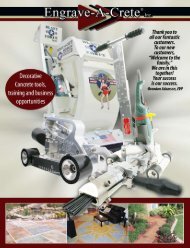msds_cr-607_olive_mist - Engrave-A-Crete
msds_cr-607_olive_mist - Engrave-A-Crete
msds_cr-607_olive_mist - Engrave-A-Crete
You also want an ePaper? Increase the reach of your titles
YUMPU automatically turns print PDFs into web optimized ePapers that Google loves.
MATERIAL SAFETY DATA SHEET<br />
CR-<strong>607</strong> OLIVE MIST<br />
SECTION I<br />
Product Identification and General Information<br />
Product Name: CR-<strong>607</strong> OLIVE MIST Date Prepared: 4/24/2007<br />
Product Class: Hydrochloric Acid Solution<br />
24 Hour Emergency Assistance<br />
HMIS Codes: Health: 3 Chemtrec: 1-800-424-9300<br />
Flammability: 0<br />
MSDS Code - J895<br />
Reactivity: 1<br />
SECTION II<br />
Hazardous Component CAS # OSHA PEL ACGIH TLV<br />
Cupric Chloride 7447-39-4 1.0 mg / m³ 1.0 mg / m³<br />
Hydrochloric Acid 7647-01-0 7.0 mg / m³ 7.0 mg / m³<br />
Sodium Dichromate 10588-01-9 .01 mg / m³ .05 mg / m³<br />
SECTION III<br />
Physical Data<br />
Boiling Point: N/E<br />
Solubility in Water: Soluble<br />
Vapor Pressure:<br />
Evaporation Rate (Butyl Acetate = 1): Slower<br />
Vapor Density: N/A<br />
Appearance: Dark Liquid<br />
Specific Gravity: 1.30 +/- .03<br />
Odor: Sharp Pungent Odor<br />
PH: 2-3 ph Freezing Point: 10ºF<br />
SECTION IV<br />
Fire and Explosion Hazard Data<br />
Flash Point (°C):<br />
None<br />
Conditions of Flammability:<br />
None<br />
Flammable Limits: LEL: N/A UEL: N/A<br />
Auto Ignition Temperature (°C): None<br />
Hazardous Combustion Products: N/E<br />
Sensitivity to Impact:<br />
N/E<br />
Sensitivity to Static Discharge:<br />
None<br />
Extinguishing Media:<br />
Alcohol, dry chemicals, water, fog and foam.<br />
Special Firefighting Procedures:<br />
Wear self contained breathing apparatus with full face piece operated in pressure demand or<br />
other positive pressure mode and full body protective clothing when fighting fire<br />
Unusual Fire and Explosion Hazards: Releases Hydrogen Chloride gas when heated. Also reacts with most metals to release<br />
hydrogen gas, which can form explosive mixture with air.<br />
SECTION V<br />
Reactivity Data<br />
Chemical Stability: Stable<br />
Conditions to Avoid: Avoid contact with strong alkalies, alkali metals.<br />
Incompatibility (Materials to Avoid): Avoid contact with strong alkalies, alkali metals<br />
Hazardous Decomposition Products: May evolve highly toxic chloride fumes.<br />
Hazardous Polymerization (Reactivity): Will Not Occur<br />
N/A = Not Applicable, N/E = Not Established, N/D = No Data, N/R = Not Required<br />
info@Con<strong>cr</strong>ete-Resurrection.com CONCRETE STAIN & SUPPLY, LLC. tech@Con<strong>cr</strong>ete-Resurrection.com 1
SECTION VI<br />
Health Hazard Data<br />
Primary Routes of Entry: Eye, Inhalation, Skin Contact, Ingestion<br />
Health Hazards (Acute and Chronic Exposures):<br />
Eyes:<br />
Acute: Rapidly causes Severe burns, possible with permanent impairment of vision<br />
Chronic: Permanent impairment of vision<br />
Skin Absorption: Acute: Irritation and possible burning<br />
Chronic: Massive overexposure could lead to kidney failure and possible death<br />
Inhalation:<br />
Acute: TLV and OSHA guide is 5 ppm ceiling for hydrogen chloride: severely irritating.<br />
Ingestion:<br />
Acute: Can cause severe tissue destruction<br />
Chronic: Kidney failure may follow and result in death<br />
Carcinogenic Data:<br />
NTP: N/E OSHA: N/E IARC: N/E<br />
Toxicological Data: N/E<br />
SECTION VII<br />
First Aid<br />
General:<br />
Eyes:<br />
Skin:<br />
Inhalation:<br />
Ingestion:<br />
Massive over exposure to solutions of this product could lead to kidney failure and death.<br />
Immediate and continuous irrigation with flowing water at least 30 minutes is imperative.<br />
Skin burn likely. Immediate, continuous, and thorough washing with flowing water for 30 minutes, remove clothing<br />
immediately. Destroy contaminated shoes<br />
Remove to fresh air if effect occurs. Call physician and /or transport to medical facility<br />
Corrosive. Do not induce vomiting. Give large amounts of water or milk if available and immediately transport to<br />
medical facility.<br />
SECTION VIII<br />
Special Protection Information<br />
Respiratory Protection: Ventilation must be sufficient to control vapor. Breathing of vapors must be avoided.<br />
Whenever exposure to vapor/<strong>mist</strong> is likely unless levels are below applicable limits, wear a properly fitted<br />
NIOSH/MSHA approved respirator. For emergencies, a self-contained breathing apparatus or full faces<br />
respirator is recommended<br />
Protective Gloves: Impervious gloves, neoprene or rubber.<br />
Eye Protection: Safety eyewear including splash guards or side shields, chemical goggles, or face shield.<br />
Other protective Equipment: Clean, body-covering clothes. Further safety equipment (apron, footwear, etc.)<br />
should be used as necessary to prevent contact with material.<br />
SECTION IX<br />
Spill or Leak Procedures<br />
Shovel or soak up spilled material into plastic container and remove to an approved chemical waste disposal area. Flush area with water<br />
directing runoff to appropriate treatment or disposal container. Never flush to sewer. Major spills should be reported according to<br />
regulations.<br />
Waste Disposal Methods: Dispose of waste in accordance with federal, state and local regulations<br />
SECTION X<br />
Shipping Data<br />
D.O.T. Shipping Name: Corrosive Liquids N.O.S.<br />
Technical Shipping Name: Hydrochloric Acid Solution<br />
D.O.T. Hazard Class: 8 - Corrosive<br />
UN/NA Number: UN1760<br />
Reportable Quantity: NA<br />
D.O.T. Labels Required: Corrosive<br />
NMFC # 44155-4<br />
Freight Class: 70<br />
N/A = Not Applicable, N/E = Not Established, N/D = No Data, N/R = Not Required<br />
2




